Fictional Materials
April 21, 2016
Some readers of this
blog must have read the title as "
frictional"
materials, since that would have been an expected topic. I've written about
friction, and the
science of friction (
tribology), in some previous articles (
Tribology, April 27, 2015,
Van der Waals Friction, August 12, 2013, and
Friction, February 1, 2012. This article is about unusual materials appearing in
fiction; and, there are quite a few, as
this Wikipedia list demonstrates. I've
winnowed my selections quite a bit, since it appears that
fantasy authors prefer to have their
dragons drink from
lakes of
magical liquids that have no
scientific substance.
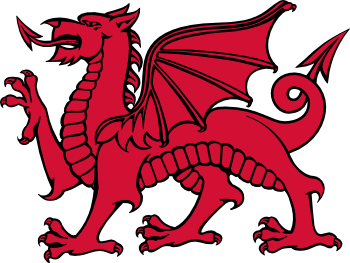
The dragon from the flag of Wales.
Wales is considered as the likely home of King Arthur, noted for slaying all sorts of monsters, including dragons.
(Via Wikimedia Commons.)
Unobtainium
Most
engineers are familiar with the fictional material,
unobtainium, whose name derives from "unobtainable" and the "-ium"
suffix used in naming 81 of the 118
chemical elements.[1] Unobtainium is the material that allows the success of your design, but you can't get it because there's no known material with the desired
properties, or the required material is too expensive or it's still in
development. The most common unobtainium is an
aerospace material having high
strength and resistance to
creep,
oxidation, and
corrosion, at very high
temperature.
Dilithium
The premise of
Star Trek is the ability of
faster-than-light travel; and that, in turn, is enabled by the fictional material,
dilithium.
Crystals of dilithium, a rare
mineral found on just a few
planets, enables the mixing of
matter and
antimatter for production of
energy. Unfortunately, the writers imagined that dilithium (Dt) was
element 87 in the
periodic table, which is actually
francium, an extremely
reactive and
radioactive element having a
half-life of just 22 minutes. A better choice would have been an undiscovered element of high
atomic number on a supposed "
island of stability."
Transparent Aluminum
The fourth
Star Trek Movie, "Star Trek IV: The Voyage Home," directed by Leonard Nimoy (March 26, 1931 - February 27, 2015), was very nearly a
comedy. In one memorable scene,
ship's engineer,
Scotty, played by James Doohan (March 3, 1920 - July 20, 2005), reveals the structure of "
transparent aluminum" to a 20th century scientist.
Aluminum, of course, is not
transparent, so transparent aluminum would be a transparent
compound of aluminum, such as
aluminum oxynitride or the sapphire crystalline form of
aluminum oxide, which is commonly used as a watch crystal. I wrote about these compounds in a
previous article (Transparent Aluminum, June 4, 2015).
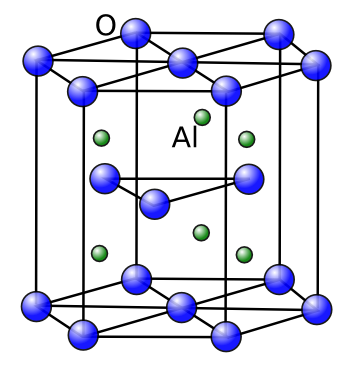
The arrangement of atoms in a unit cell of sapphire.
Sapphire has trigonal crystal structure, represented by the hexagonal cell shown.
The space group is designated R3c
(Illustration by the author using Inkscape.)
Adamantium
Adamantium, sometimes called
adamant or adamantine, is an extremely
hard material, in the same class as
diamond. For some reason, the
gates of hell are supposedly made of this material. While
John Milton writes about this in
Paradise Lost, his source would have been
Virgil's description of the gates of
Tartarus in the
Aeneid.
Respicit Aeneas subito, et sub rupe sinistra moenia lata videt, triplici circumdata muro, quae rapidus flammis ambit torrentibus amnis, Tartareus Phlegethon, torquetque sonantia saxa. Porta adversa ingens, solidoque adamante columnae, vis ut nulla virum, non ipsi exscindere bello caelicolae valeant.[2]
|
Aeneas straightway by the leftward cliff beheld a spreading rampart, high begirt with triple wall, and circling round it ran a raging river of swift floods of flame, infernal Phlegethon, which whirls along loud-thundering rocks. A mighty gate is there columned in adamant; no human power, nor even the gods, against this gate prevail.[2]
|
Krell metal
The
plot of the
movie Forbidden Planet concerns an
expedition to Altair IV, the fourth planet of the
star Altair.[3] This planet was once populated by the Krell, an
extinct race that left behind many
artifacts, including many made from Krell Metal, a nearly indestructible
alloy. From the
screenplay, it appears that Krell Metal is much stronger than adamantium. Forbidden Planet has been compared to
Shakespeare's The Tempest, with the part of
Caliban played by
Robbie the Robot.
Cavorite
Cavorite is an
anti-gravity material appearing in "
The First Men in the Moon," a 1901
novel by
H. G. Wells. While this appears at first fantastic, the
gravitational properties of antimatter are still unknown. This material enables a voyage to the
Moon in a
spherical spaceship having movable sheets of cavorite to allow steered
propulsion. While the Selenite creatures found there are interesting, my favorite
lunar inhabitants are the
Cat-Women of the Moon.[4]
Ice-Nine
ice-nine, not to be confused with the actual
ice-IX phase of
water, is a fictional material in
Kurt Vonnegut's novel,
Cat's Cradle. Unlike Vonnegut's ice-nine, ice-IX only exists below 140
kelvin at
pressures from 200 - 400
MPa. Vonnegut's phase of
water ice has the dangerous property that it will spontaneously
crystallize water into ice-nine under
normal temperatures and pressures. There's a problem, however, that ice-nine will only melt at 45.8 degrees
Celsius, slightly above
Earth ambient.
Ice-nine eventually leads to the
solidification of all the world's water, and destruction of
life on Earth. Vonnegut, who worked for a time in the
public relations office at
General Electric in
Schenectady, New York, said that the ice-nine idea came from
Nobel Chemistry Laureate,
Irving Langmuir of GE's
research laboratory. Langmuir apparently pitched the idea of an ice that's solid at room temperature to H.G. Wells, who had visited the laboratory. Langmuir and Wells never published anything about ice-nine; and, when they had both died, Vonnegut decided to use the idea himself. He modeled the ice-nine inventor, Dr. Felix Hoenikker, on Langmuir.
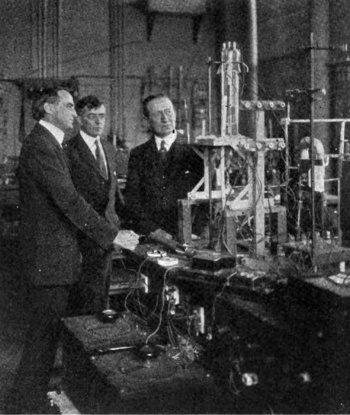
Left to right, Willis R. Whitney, Director of the GE research laboratory, Irving Langmuir, and Guglielmo Marconi, August, 1922.
They're looking at a recently developed 20 kilowatt triode vacuum tube.
Both Langmuir and Marconi were Nobel Laureates, Langmuir in chemistry and Marconi in physics.
(Via Wikimedia Commons.)
Administratium
Administratium, sometimes known as bureaucratium, is a material with a supposed negative
half-life; that is, its quantity becomes greater with time. This reminds me of the
committee members in charge of "Policies and Procedures" at my former
employer. At one point, they decided that they needed to write a policy and procedure on writing policies and procedures. Administratium is the
elementary particle from which
bureaucratic systems are made.
Kryptonite
Kryptonite is a mineral containing some radioactive element from
Krypton, the home planet of
Superman. The
explosion of Krypton sent pieces of kryptonite Earthward, and it depletes Superman's strength when he comes near it. Kryptonite has entered
popular culture as a reference to anything that weakens a person, the most recent example being in
Shut Up and Dance, a 2014 song by the
American music group,
Walk the Moon, where they sing, "We were victims of the night, the chemical, physical, kryptonite..."
Scientists from the
Institute of Physical Chemistry of the Polish Academy of Sciences have predicted the existence of
KrO, a compound of the
noble gas,
krypton, with
oxygen.[5-6] This kryptoxide, when crystallized, could be called kryptonite. In any case, such a name was enough to encourage me to read their
paper.
I can remember while taking
high school chemistry that my
teacher was very excited about the discovery of
xenon tetrafluoride (XeF
4). Such a discovery was significant, since the noble gases were always thought by
chemists as being
inert and incapable of forming
compounds. Today, quite a few
noble gas compounds have been
synthesized under
high pressure conditions.
The
Polish scientists did a
thermodynamic calculation of the stability of compounds of krypton and oxygen for Kr:O
ratios of 1:1, 1:2, 1:3 and 1:4 for pressures from 10-500
GPa.[5] They discovered that around 300 GPa the monoxide, KrO, should form in two stable configurations, as shown in the figure.[5] In these
crystals,
atoms of oxygen link atoms of krypton in
polymer-like chains, and the solids are predicted to behave
electrically as
semiconductors.[6]
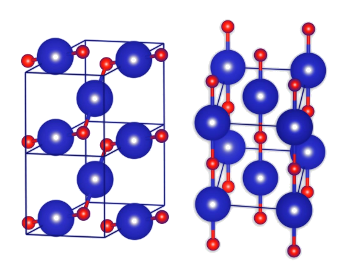
Two crystal forms of krypton monoxide, KrO. The left, zig-zag form is more stable than the right, chain form. The larger, blue atoms are Kr, with oxygen colored red.
(Institute of Physical Chemistry of the Polish Academy of Sciences image.)
Such high pressures are accessible through use of
diamond anvil cells, so KrO can be synthesized in the
laboratory, and that might be the only place it could be found. Says
Patryk Zaleski-Ejgierd, one of the study
authors,
"Our krypton monoxide, KrO, probably does not exist in nature. According to current knowledge, deep in the interiors of planets, that is, the only place where there is sufficient pressure for its synthesis, oxygen does not exist, nor even more so, does krypton."[6]
The research team found another, less stable compound, krypton tetroxide (KrO
4), which should be
metallic. It would form only above 340 million
atmospheres.[6]
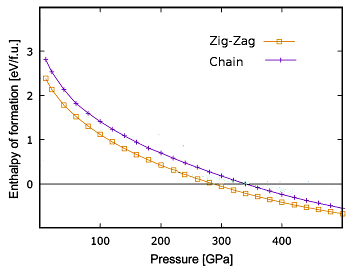
Enthalpy of formation for two KrO phases as a function of pressure.
The zig-zag form is stable at a slightly lower pressure (285 GPa).
(Fig. 2 of ref. 5, simplified, Creative Commons licensed.)
![]()
References:
- I was surprised at how many there are. The calculation is easy to do in LibreOffice, my preferred spreadsheet program. If the list of element names is in column A, you can sum column B containing this formula: =IF(ISNUMBER(SEARCH("ium",A1)),1,0).
- P. Vergillius Maro, "Aeneid," book VI, ll. 548-554, via the Perseus Digital Library. Latin from J. B. Greenough, "Vergil. Bucolics, Aeneid, and Georgics," Ginn & Co. (Boston, 1900). English translation from Vergil, "Aeneid," Theodore C. Williams. trans., Houghton Mifflin Co. (Boston, 1910).
- Forbidden Planet (1956, Fred M. Wilcox, Director) on the Internet Movie Database.
- Cat-Women of the Moon (1953, Arthur Hilton, Director) on the Internet Movie Database. This film is notable for the moonscapes by Chesley Bonestell.
- Patryk Zaleski-Ejgierd and Pawel M. Lata, "Krypton oxides under pressure," Scientific Reports, vol. 6 (2016), Article no. 18938 doi:10.1038/srep18938. This is an open access publication with a PDF file available here.
- Superman can start worrying -- we've got the formula for (almost) kryptonite!, Institute of Physical Chemistry of the Polish Academy of Sciences Press Release, March 2, 2016.
Permanent Link to this article
Linked Keywords: Blog; friction; frictional; material; science; tribology; fiction; winnowing; winnow; fantasy literature; author; dragon; lakes; magic; paranormal; liquid; scientific; flag; Wales; King Arthur; monster; Wikimedia Commons; engineer; unobtainium; suffix; chemical element; materials properties; research and development; aerospace; strength of materials; creep; oxide; oxidation; corrosion; temperature; Star Trek; faster-than-light; dilithium; crystal; mineral; planet; matter; antimatter; energy; chemical element; periodic table; francium; chemical reaction; reactive; radioactive; half-life; atomic number; island of stability; Star Trek IV: The Voyage Home; Leonard Nimoy (March 26, 1931 - February 27, 2015); comedy; ship's engineer; Montgomery Scott; Scotty; James Doohan (March 3, 1920 - July 20, 2005); transparent aluminum; 20th century; scientist; aluminum; transparent; chemical compound; aluminum oxynitride; sapphire; crystalline; aluminum oxide; watch crystal; atom; unit cell; trigonal crystal structure; hexagonal crystal system; hexagonal cell; space group; Inkscape; adamantium; adamant; hardness; hard; diamond; gates of hell; John Milton; Paradise Lost; Virgil; Tartarus; Aeneid; Aeneas; cliff; rampart; defensive wall; river; flame; Phlegethon; rock; gate; adamant; human; deity; god; plot; film; movie; Forbidden Planet; expedition; star; Altair; extinction; extinct; extraterrestrial life; race; artifact; alloy; screenplay; William Shakespeare; Caliban; Robbie the Robot; anti-gravity; The First Men in the Moon; novel; H. G. Wells; gravitational properties of antimatter; Moon; sphere; spherical; spacecraft; spaceship; propulsion; lunar; Cat-Women of the Moon; ice-nine; ice-IX; phase; water; Kurt Vonnegut; Cat's Cradle; kelvin; pressure; MPa; water ice; crystallization; crystallize; Standard conditions for temperature and pressure; normal temperatures and pressures; Celsius; Earth; ambient; freezing; solidification; organism; life on Earth; public relations; General Electric; Schenectady, New York; Nobel Prize in Chemistry; Nobel Chemistry Laureate; Irving Langmuir; research; laboratory; Willis R. Whitney; Guglielmo Marconi; kilowatt; triode; vacuum tube; Nobel Laureate; chemistry; physics; administratium; committee; employer; elementary particle; bureaucracy; bureaucratic system; kryptonite; Krypton; Superman; explosion; popular culture; Shut Up and Dance; American; musical ensemble; music group; Walk the Moon; Institute of Physical Chemistry of the Polish Academy of Sciences; Kr; O; noble gas; scientific literature; paper; high school; teacher; xenon tetrafluoride; chemist; inert; chemical compound; noble gas compound; chemical synthesis; synthesize; high pressure; Poland; Polish; thermodynamics; thermodynamic; calculation; ratio; pascal; GPa; crystal; atom; polymer; electrical; semiconductor; crystal habit; crystal form; diamond anvil cell; laboratory; Patryk Zaleski-Ejgierd; author; nature; metal; metallic; atmosphere; standard enthalpy of formation; function; Forbidden Planet (1956, Fred M. Wilcox, Director); Cat-Women of the Moon (1953, Arthur Hilton, Director).